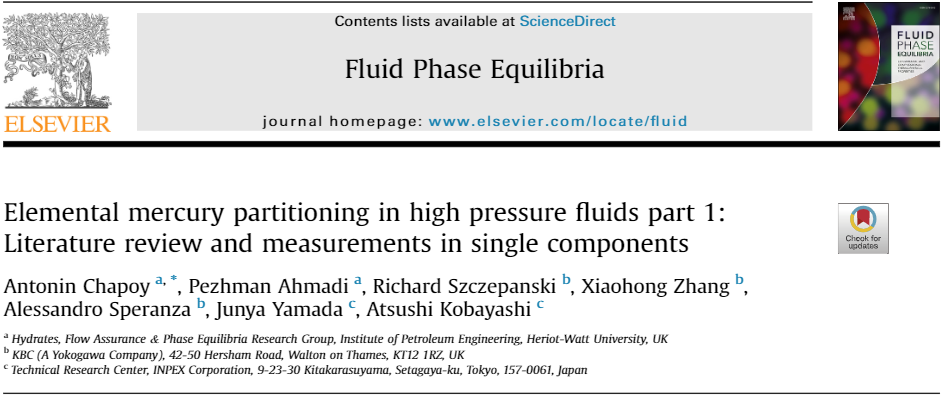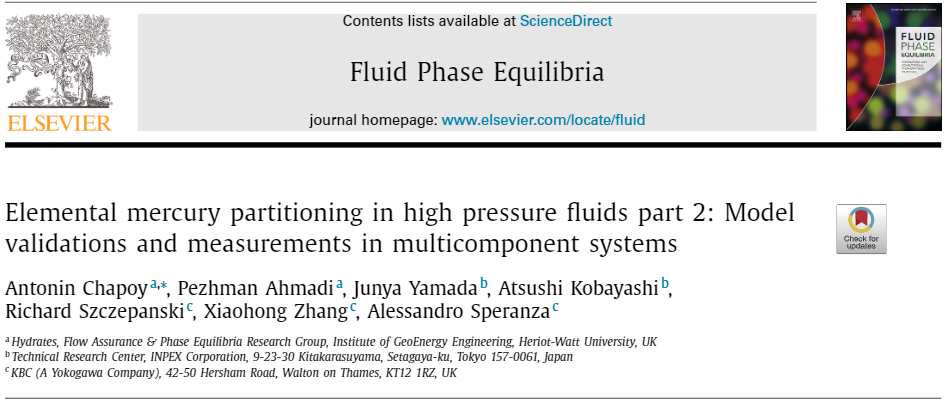Principal Investigator: Professor Antonin Chapoy
Although not present in every gas or oil field, mercury contamination has been reported in several locations worldwide. Hotspots of mercury contamination appear to be spread globally, with higher concentrations in Southeast Asia, North Europe (Germany/Netherlands) and the Middle East [1]. Mercury contamination represents a big risk for the oil and gas industry. Although normally present in small amounts, its effects may be very damaging for the industry. It is an obvious Health Safety and Environmental (HSE) hazard for the staff and the environment. If not detected promptly and removed from the fluid, Mercury can easily be dispersed in the immediate environment, with tragic consequences for the health of the workers on the plant and major risks of contamination of the wider environment. Moreover, mercury is highly corrosive and its accumulation in the pipelines or in operating units, like heat exchangers or separators, may compromise the integrity of the steel walls and cause leaks with associated risk of fire and further risks of contamination from the dispersion of hydrocarbons in the environment [2,3].
The strategies adopted to mitigate risks associated with mercury are obviously very costly. While a conservative approach in design and construction of the facilities is obviously necessary, the adoption of excessive design margins may lead to excessive CAPEX and OPEX or reduced operating capacity. For instance, the correct sizing and positioning of a mercury removal unit may have a major impact on the economics of the project. The ability to determine with improved accuracy the risk of accumulation of mercury across the plant and assess within safety margins, the correct sizing and operating conditions of the mercury removal units would therefore provide great benefit to the industry overall. With increased modelling and simulations capabilities, engineers would be able to assess more effectively the risks associated with mercury contamination, maximize the effectiveness of capital and operational expenditure, and improve their general capability to operate the plant within its actual productive limits, without compromising the safety of the staff and of the environment.
The aim of this project was to conduct an integrated experimental and modelling study addressing the solubility of elemental mercury in dense fluids to:
- Iidentify gaps in literature.
- Determine mercury content in key components: methane, ethane, propane, nitrogen and carbon dioxide.
- Develop/tune modelling tools to predict the phase behaviour of mercury in high pressure systems.
- Validate the model by measuring mercury contents in multicomponent systems.
Project Sponsors
This project was financially supported by Net Zero Technology Centre, KBC and INPEX.

Project Outputs
Some parts of the results from this project have been published in peer-reviewed journals:


References
[1] A. Chalkidis, D. Jampaiah, P.G. Hartley, Y.M. Sabri, S.K. Bhargava, Mercury in natural gas streams: A review of materials and processes for abatement and remediation, J. Hazard. Mater. 382 (2020) 121036. doi:10.1016/j.jhazmat.2019.121036.
[2] M.D. Bingham, Field Detection and Implications of Mercury in Natural Gas, SPE Prod. Eng. 5 (1990) 120–124. doi:10.2118/19357-PA.
[3] J.H. Harfoushian, Quantification of low levels of mercury in gas reservoirs using advanced sampling and analysis techniques, Proc. – SPE Annu. Tech. Conf. Exhib. 3 (2013) 1744–1752. doi:10.2118/166220-ms.
